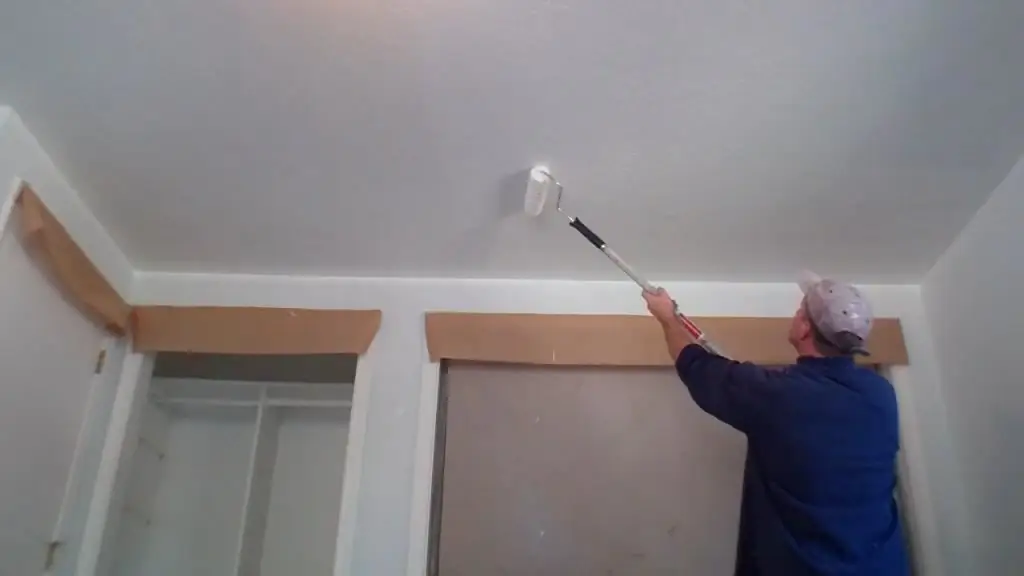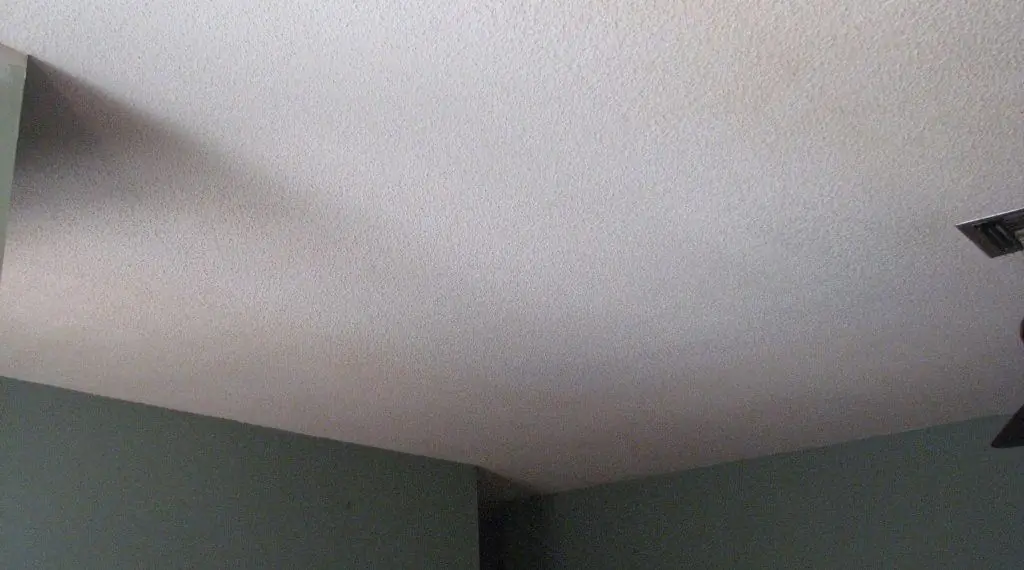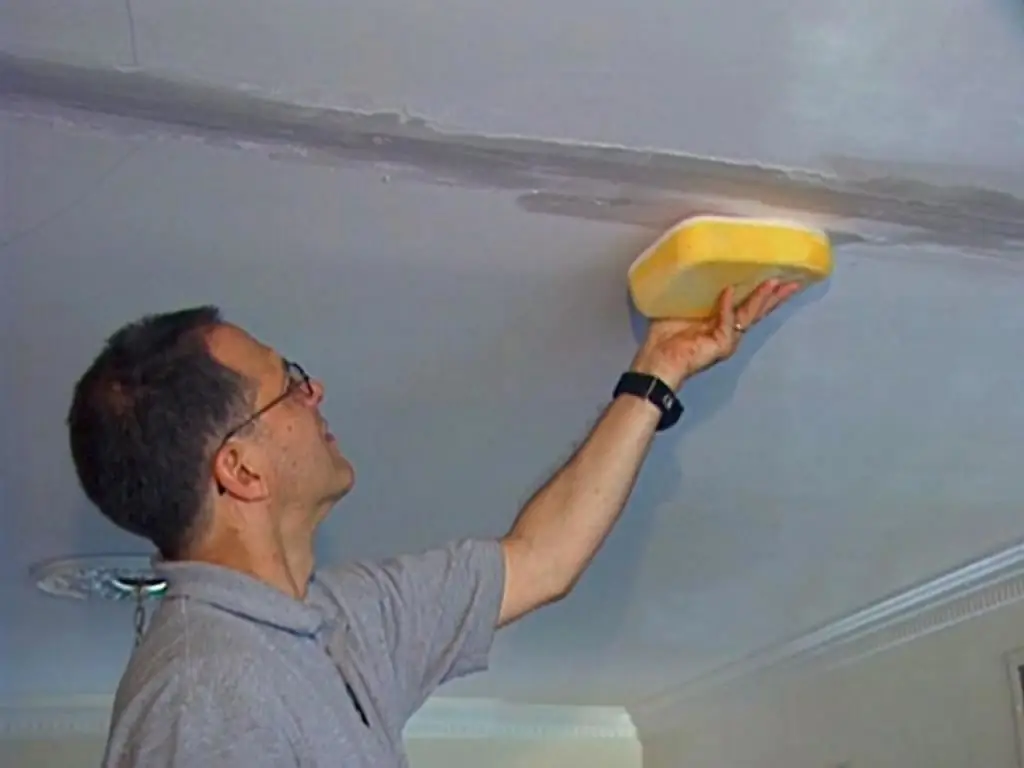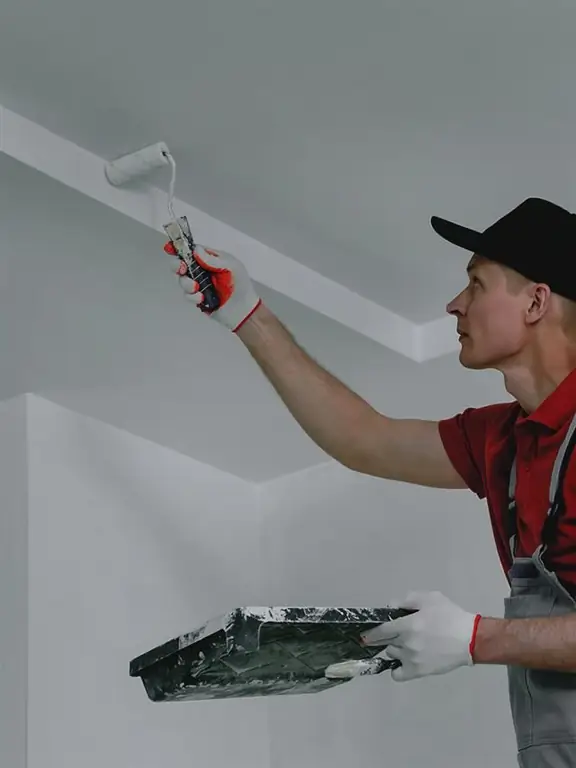Finishing work requires a phased implementation and following all the requirements. In order for the emulsion and other formulations to lay flat, the base must be pre-treated. Therefore, the answer to the question of whether it is necessary to prime the ceiling before painting is definitely positive. After all, this guarantees an extension of the service life.

Processing benefits
The main function of a primer is to improve adhesion between materials. Due to the compaction and smoothing of the surface, the compositions lie evenly and are securely fixed to each other. The primer creates a film on the surface, which reduces the risk of dust and other particles getting under emulsions or varnishes, which can reduce the adhesion strength of materials.
As for whether it is necessary to prime the ceiling before painting, most experts recommend doing this to extend the shelf life of the applied products. Thanks to the processchemical action between the elements, the adhesion process begins, which significantly strengthens the applied layers. Due to the primer, the process of regulation of moisture absorption takes place, it does not penetrate into the base, but the following layers do not dry out.
Also, pre-treatment of the surface contributes to the even application of emulsion and other compounds, so you should not once again wonder if the ceiling needs to be primed before painting, as this is an effective and important step in the process of creating a smooth and durable surface.

Preparation and process
Depending on the type of coating and the materials used, some steps differ or are not performed, but in general, the technology for performing the work is universal in any case. Although the list of works is small, but the implementation can take a lot of time and effort, because between each step of applying the compositions you have to wait for all layers to dry well and there is no accumulation of moisture inside.
The surface is cleaned from the remnants of the old coating. It can be the remains of wallpaper, emulsion or paint. Cleaning is carried out at the preparatory stage with a spatula. Further, all debris and large particles of unnecessary material must be removed so that there are no problems in further work. The ceiling must be cleaned of dust with a rag and a broom. There may be cracks or irregularities on the surface, they must be corrected, otherwise, after finishing, all the flaws may appear. Next, a layer of primer is applied to level and protect against mold. After the master has driedputty is applied and the surface is leveled. While it dries, it is advisable to lay the floor, making a wet cleaning so that excess dust does not rise. Regarding whether it is necessary to prime the ceiling before painting, experts advise doing this in order to improve adhesion between layers and speed up the drying process.

Key actions
If the decision on priming is made, it is necessary to choose the type of mixture for work. Ready-made mixtures are sold in hardware stores, but consumables for the base are selected depending on the type of paint, because each type has its own drying speed and density. If the area to be treated is too large, then you can buy a concentrate, it will save some money, it does not differ in quality from a conventional primer. The concentrate must be diluted in water to the desired level of density.
There are different opinions about whether it is necessary to prime the ceiling before painting with a water-based base. Some masters advise not to do this, since there is enough moisture in the paint for the layers to adhere well to each other and a chemical reaction occurs, but additional priming will speed up the drying process. Therefore, if the timing of the repair work is important, then it is better to use a primer.

Tool selection
For a quality process, you need to choose a roller with a dense pile so that a sufficient amount of emulsion is collected and the composition penetrates well into all cracks and closes irregularities. You can buy rollers in construction storeswith a long handle to reach the ceiling from the floor, but this may not be very convenient, so in most cases, standard rollers are bought.
Be sure to prime the ceiling before painting with a fleecy roller, not a sponge one, since the latter does not give a quality result. To mix the paint, a tray is used, into which it is convenient to lower the roller for uniform impregnation with the mixture. For staining the corners, a maklovitsa is used. Due to the long pile, it is convenient to process hard-to-reach places with it.
For quick drying in winter, you can use a fan, thanks to which the layers will dry several times faster. To avoid the question of how to prime the ceiling before painting, you need to choose the mixture in advance.

Expert Tips
In order for the priming process to be of high quality, it is necessary to monitor the amount of the mixture on the roller and apply it evenly. The roller must be rolled well on the surface so that the primer penetrates the top layer and covers all the imperfections.
If the soil is strongly stretched along the ceiling, then due to a too thin layer, there will be no efficiency from the process. Therefore, it is necessary to monitor a sufficient amount of primer on the roller and regularly moisten the tool in the mixture. Some formulations can be quickly absorbed, so after the first layer has dried, apply another one to consolidate the result. If the surface absorbs quickly, experts advise applying even three coats of primer.
Further work can be carried out only after complete dryingprimer layer, otherwise the peeling process will begin from the surface of materials that have not dried. On the packaging of mixtures, manufacturers indicate the optimal time for which the quick drying process should occur. On average, it is from 3 to 5 hours. As for which primer to prime the ceiling before painting, it depends on the materials on which the base will be applied.

Choice of base
Much depends on the type of coating on which the primer layer will be applied. Therefore, manufacturers have developed several primer options that provide a quality finish to any surface.
The label indicates materials that are suitable for compatibility with the primer, if the mixture is bought for the first time, it is better to consult a specialist to take into account all the advantages of the composition. The primer can be deep penetration and for surface finishing. The first option is well suited for applying several layers and for major repairs, for cosmetic surface treatment, a conventional primer is sufficient.
Deep penetration mixture is inexpensive, but goods made by a German company are more expensive due to transportation. The primer is well absorbed even into wooden surfaces, experts advise to pay attention to the alkyd type.
To make the right choice about which primer to prime the ceiling before painting, you need to pay attention to the composition of the mixture and the presence of antiseptic additives that prevent the appearance of fungus and mold in rooms withhigh levels of humidity.

Recommendations and information
The quality of the work depends on the density of the mixture. If the soil is liquid, then droplets may form on horizontal surfaces. To avoid this, it is necessary to roll over the surface after complete processing, so that it dries evenly and without soil accumulation. It will also help avoid stains.
Do I need to prime the putty before painting the ceiling? Of course, if the quality of work and its durability, protection from moisture and a perfectly flat surface as a result are important. Do not mix different finishing primers as this may cause delamination on the surface and unevenness.
Quartz blends
Soils based on this are used when the surface does not absorb moisture, which complicates the process of drying and applying other layers. This happens after mastic or oil paint with a high density.
Quartz-based primers are also called concrete contacts due to the possibility of penetrating into such surfaces. Also, after application, they create a film that adheres well to the following layers of finishes. Therefore, the answer to the question of whether it is necessary to prime the painted ceiling before painting will be positive, since this is an additional opportunity to increase the adhesion between the finishing layers to create a perfectly even surface.
Features of working with putty
It is imperative to apply a primer to the putty surface so that the next layersapplied evenly and dries faster. Almost any type of primer is suitable for this, although it is better not to use dense mixtures, as this increases the drying time. Experts and craftsmen advise not to think about the question of whether it is necessary to prime the putty ceiling before painting, but be sure to complete this stage for a quality repair.
When choosing a primer, you should pay attention to the composition of the mixture and the drying time, the smaller it is, the thinner the layer of primer creates on the surface. For a better choice, you can consult with a specialist in the store, this will help you buy the right product.






